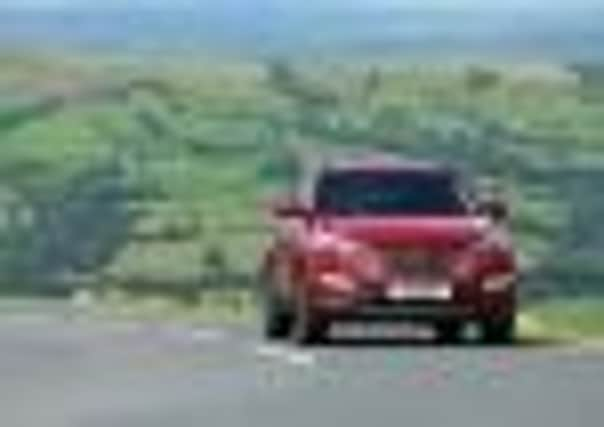I believe in Santa Fe


The lowest-spec of the three trim levels available, the Style, starts at £25,495 – that’s £4,000 more than its predecessor. But, says Hyundai, nobody bought the low-end predecessor, so it doesn’t really matter. The firm enjoyed most success with the Premium trim and indeed, expects around 70 per cent of its new Santa Fe sales to be at this level – even though Hyundai says the new Style is around the same standard as the previous Premium. The Premium seven-seater 4WD automatic I drove comes in at £31,895, so there’s a hefty bit of repositioning right there.
There’s more to it than that though. It’s been to the gym and looks meaner – it’s 40mm longer, 5mm wider and sits lower than its weedier-looking forebear. Its rugged looks are further enhanced by the imposing snout, twin exhaust and black body cladding.
Advertisement
Hide AdAdvertisement
Hide AdHyundai has listened to customers who had criticised the interior as being too cramped and too spartan. There’s more room for everyone, and the driver now has an array of buttons to play with on the more stylish and intuitive dash as well as a seven-inch sat nav. Leather seats are standard in the Premium too. More importantly, the indicator stalk is on the left this time, where it should be. Hyundai expects most buyers to plump for the seven-seat option, the back two seats of which fold down into the floor to leave an impressive 2,247 litres of space in the boot.
All variants come with the same 2.2-litre CRDi engine, which produces a reasonable 197ps and 311lb ft of torque, although the automatic transmission doesn’t seem to be in a huge hurry about anything much. Suspension is specially tuned for UK roads, i.e. potholes, and is comfortable enough while steering is fairly anonymous.
For the first time, there’s a 2WD option, but Hyundai reckons most people will opt for the 4WD version with its “torque on demand” system which only overrides the usual front-wheel-drive mode when its sensors reckon you’re in trouble. You can also switch on the 4WD manually, should the mood or the terrain take you, but although this car can off-road – it even has a very effective and alarmingly noisy hill control brake to prove it – Hyundai knows that if you want to off-road properly, you’ll probably buy a Land Rover.
As Hyundai marketing manager Andrew Cullis said at its launch, the company wanted to make a car that’s good at everything it does: “More of a Jessica Ennis than a Usain Bolt.”
On top of that improved styling and extra space inside, various gadgets help justify the heftier price tag. The trailer stability assist system, senses when a trailer or caravan is swaying and reduces torque and speed accordingly. The Santa Fe is fitted with sensors which can tell the difference between a person and a lamppost in a crash and pop up the bonnet to protect the pedestrian.
Look closer still and the Santa Fe becomes even more of a tempting proposition. Fuel economy is up by 11.6 per cent and CO2 emissions are down by 11.9 per cent compared to its predecessor, making for savings in benefit-in-kind tax.
Then there’s the insurance. You know you’re on to a winner when a car boasts a little piece of technology, engineering or design that makes you want to buy a hat just so you can take it off to the clever sods that came up with it. Innovations such as the head-up display, the heated seat, even the “curry hook” in the Land Rover Discovery 2, which stops your takeaways or shopping bags sloshing about the passenger footwell. Genius.
The Santa Fe boasts similar smart thinking in its elegantly thrifty philosophy, and anyone who’s ever followed a Haynes manual to fix something on their car will be able to understand it. Simply put, wherever removing something like a bumper from the old Santa Fe may have been a spanner-melting, knuckle-scraping 20-step process, Hyundai has streamlined it down to the minimum. This means the time a mechanic spends on various jobs – such as replacing a bumper after a crash – is reduced, which in turn means the cost to your insurance company is also reduced. Meanwhile, after crash-testing, the most expensive bits in the engine bay have been squirrelled away in the safest possible area so they are less likely to be damaged in a crash. The result: a drop of ten insurance groups from 29 to 19, which Hyundai reckons could account for a saving on your premiums of up to £150 per year.
Advertisement
Hide AdAdvertisement
Hide AdCombined with the improved fuel efficiency and tax reduction, this makes for a saving of £1,700 over three years, compared to the previous Santa Fe.
So the price has been repositioned. But so have the look, style, equipment level and running costs of the Santa Fe, making it an attractive option in the crowded SUV market.
CAR Hyundai Santa Fe Premium 7-seat automatic
PRICE £31,895
PERFORMANCE Max speed 118mph; 0-62 mph 10.2 secs
MPG 41.5 combined
CO2 EMISSIONS 243g/km